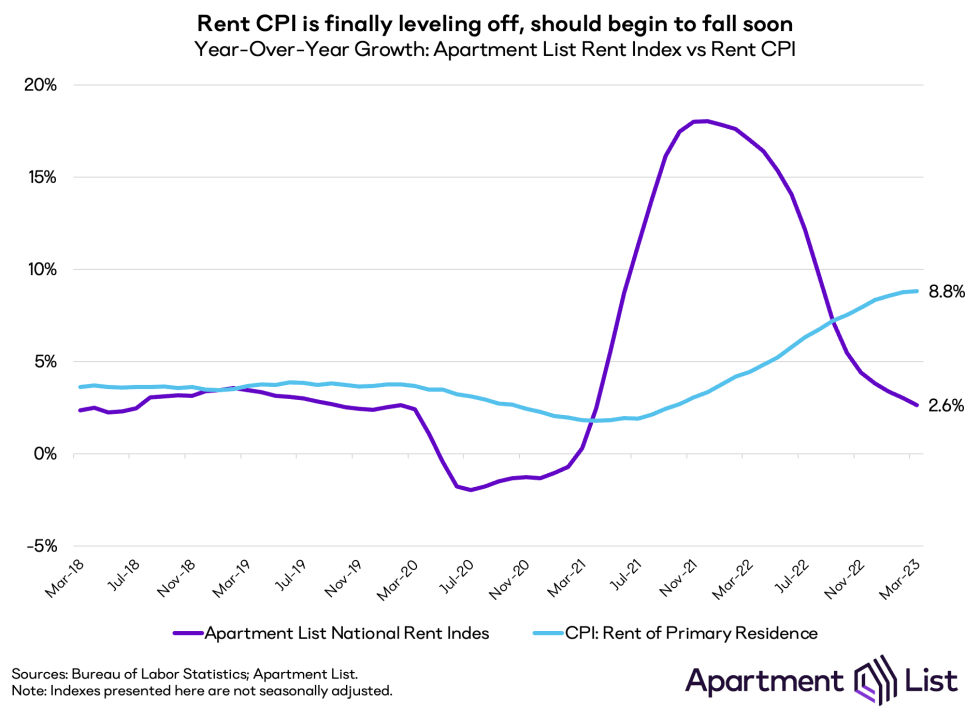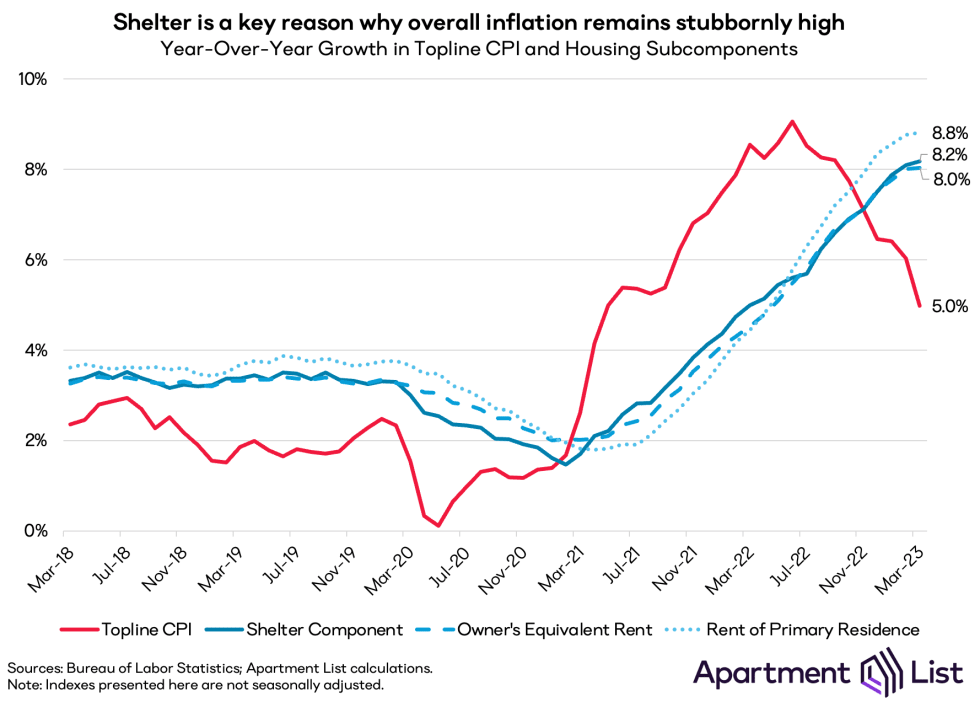Rent CPI is finally peaking
- The rent component of CPI increased by 0.5% month-over-month in March, down from a 0.7% increase in February. Rent CPI is now up 8.8% year-over-year, unchanged from last month, indicating that the rent component of CPI is finally levelling off and should begin to fall in the months ahead.
- Topline CPI increased 0.3% month-over-month, but year-over-year inflation continued to cool, falling to 5%, down from 6% last month. Even though overall inflation is cooling, the housing component is continuing to keep it elevated, and was the dominant factor contributing to this month’s overall increase.
- CPI rents, however, reliably lag movements in market rents by 3-5 quarters. The Federal Reserve is well aware of this relationship, clarifying that they also track private market-based indices, including Apartment List Rent Estimates, to understand where CPI rents will trend in coming months.
- Apartment List’s national rent index is currently logging just 2.6% year-over-year growth, a figure that has been falling rapidly for over a year. Because our index serves as a leading indicator for the housing components of CPI, we expect rent CPI to cool steadily in the months ahead.
Rent CPI has finally leveled off, as predicted by the AL rent index
Today’s CPI release shows that the year-over-year growth rate of the rent component has finally leveled off, coming in at 8.8 percent in March, which is flat compared last month. On a month-over-month basis, rent CPI increased 0.5 percent in March, down from 0.7 percent in February. In contrast, the Apartment Rent national rent index is currently up by just 2.6 percent year-over-year, a growth rate that has been cooling rapidly for over a year after peaking at a staggering 18 percent in December 2021.

The divergence of our index from the rent component of CPI may appear counterintuitive, but it actually reflects the fact that the two indexes are simply designed to capture different things. Specifically, the Apartment List rent index measures composition-controlled price changes for new leases, while the CPI tracks rent changes across all households (for a more in depth explanation of this difference and of how housing costs are incorporated into CPI, see this explainer article). Because of these differing methodologies, our index can effectively serve as a leading indicator for the rent component of CPI, as confirmed in a recent analysis by economists at the Cleveland Fed. Given this reliable lag, we knew that it was just a matter of time before rent CPI hit its peak, and that time has now arrived. Going forward rent CPI will gradually fall, helping topline inflation to cool more rapidly.
Housing costs are keeping overall inflation elevated
The coming cooldown in rent CPI is crucially important, as housing costs are currently one of the primary factors keeping overall inflation elevated. As a reminder, the “shelter” component of CPI – which includes both renter-occupied and owner-occupied housing costs – is the single largest component of topline CPI, comprising one-third of the overall index. And because costs for owner-occupied housing are measured with the concept of “owner’s equivalent rent,” trends in market rents are the key determinant of not just the rent component, but of the shelter component as a whole.

As of today’s release, the shelter component of CPI is up by 8.2 percent year-over-year, tracking closely with its rent subcomponent. For much of 2021 and 2022, the shelter component was logging slower growth than topline CPI, which was being elevated by volatile food and energy prices. But now, the reverse is true – shelter is running substantially hotter than topline CPI, and is preventing overall inflation from normalizing more quickly. If not for the shelter component, the seasonally adjusted figure for topline CPI would have actually fallen month-over-month in March. And if shelter costs were excluded, inflation over the past year would be up just 3.4 percent rather than 5 percent. Thankfully, once the shelter component of CPI catches up to our index and begins reflecting the cooling that has taken place in the housing market over the past year, it will gradually begin exerting less upward pressure on inflation. This month represents the start of a turning point for shelter CPI, representing a major milestone in the comedown from this inflationary cycle.
If you’re interested in speaking further with a member of the Apartment List research team about the latest inflation numbers, please reach out to us at research@apartmentlist.com
Share this Article
